The
Home Page Selection
If
you require further information on any
print featured here, please contact
us.
When
a print has been sold it will be marked
as Sold.
A
growing archive of selections
from previous Home pages is featured in
the
Home
Page Selection Archive |
|
See
also :
Click
on a thumbnail (left)
to link directly with the entry for that
print, or scroll down to view all the selected
prints from the current Home
Page.
Images
are not to relative scale (see stated dimensions) and also at only modest resolution.
If you wish to view extracts of an image at higher resolution, please Contact us.
|
|
|
|
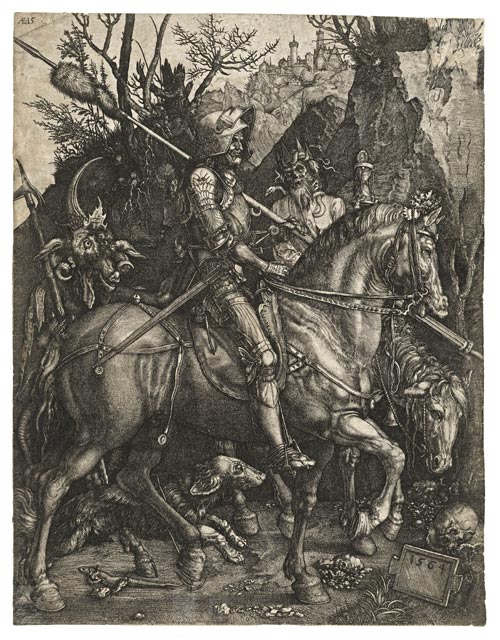
| |
JAN WIERIX
Antwerp 1549 – c1620 Brussels
Jan, or Johannes, was the eldest of the three precocious Wierix brothers. Jan was only twelve years old when he made his first copy of a Dürer engraving, proudly announcing his age on the print. He was only three years older when he copied Dürer’s Knight, Death and the Devil in 1564.
As a journeyman he entered the employment of Christophe Plantin in 1569. Plantin later complained of the disorderly behaviour of the young Wierixs who drank and got into debt, pawning their tools which he had to redeem.
Perhaps Jan’s behaviour improved when he was admitted a Master in the Antwerp Guild of St Luke in 1572.
Dürer’s Knight Death and the Devil
Mauquoy-Hendrickx 1484 ii/iv;
New Hollstein1996 ii/iv
245 x 187 mm
Engraving, 1564.
The plate dated and ‘signed’ with Wierix’s age Æ 15 (aged 15).
A copy in reverse omitting Dürer’s monogram.
A very good impression, before the addition of any addresses.
On paper watermarked with a castellated Gateway.
Trimmed to the plate.
Several repairs, mainly to the sheet edges.
The top right and lower left corners made up.
Sold
Dürer himself referred to this subject only as Reuter (Rider).
Writing in admiration of Dürer’s engraving in 1550 Vasari characterized it as a depiction of human fortitude.
Sandart in 1657 called it “The great Christian Knight”.
Erasmus’ Enchiridion militis christiani (Handbook of the Christian Knight), which Dürer probably knew from either the 1502 or 1509 editions, stipulates that every Christian must be a soldier in the service God, traversing the rough path of life on earth, fortified by the weapons given by his faith.
Return to top ^ |
|
|
|
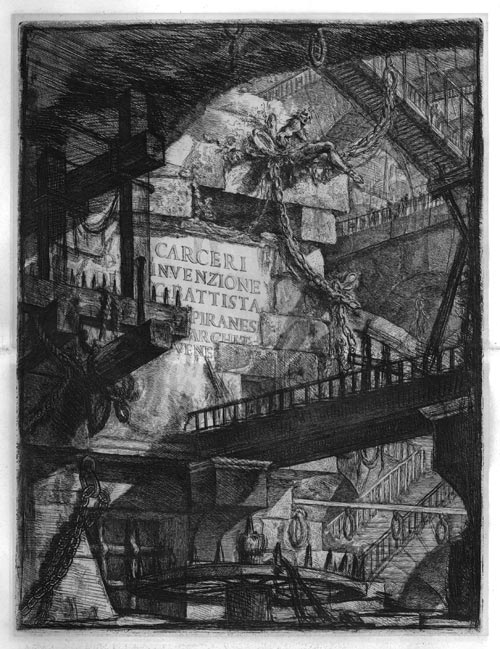 |
|
GIOVANNI BATTISTA PIRANESI
Mozzano di Mestre 1720 – 1778 Rome
Among Piranesi’s earliest plates, c1745, were the first states of fourteen of the Carceri.
Capricci inventions, related to his Venetian origins and early theatrical stage training, they were published by Bouchard & Gravier in the 1740’s.
Early in the 1760’s and in the following years Piranesi reworked the plates extensively through a succession of states, influenced by his response to Roman architecture, making them darker, and introducing dramatic new motifs related to punishment and torture, into their composition. He etched two further plates and published the series with the title Carceri d’Invenzione (Imaginary Prisons).
Of his architectural fantasies, Piranesi commented
The speaking ruins have filled my spirit with images that accurate drawings could never have succeeded in conveying.
Title plate to the Carceri d’Invenzione
Pl. I Carceri; Robison 29 v/vi
542 x 414 mm
Original etching, c1745-65.
The plate signed.
A lifetime impression, on heavy laid Bracciano paper watermarked with a lily in a double circle with B above (Robison 36) dating from the mid-1760’s to early 1770’s.
Usual horizontal central fold, supported verso.
Time-stained around the plate edges.
Sold
Return to top ^ |
|
|
|
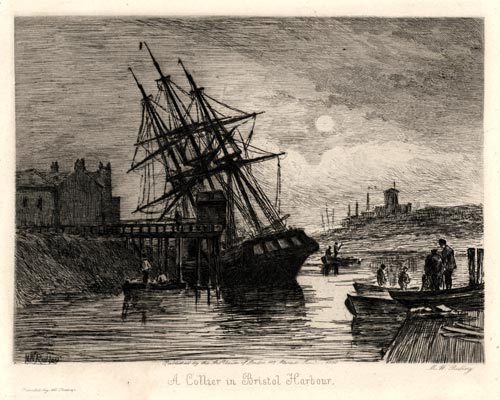 |
|
MATTHEW WHITE RIDLEY
Newcastle upon Tyne 1837 – 1888 London
A marine painter and etcher, Ridley was a fellow student of Whistler in Paris in the 1850’s and joined the Société des Aquafortistes when it was founded in Paris in 1862.
In the 1880’s he set up his own art school in London and was much appreciated as a teacher. After his death his students formed themselves into The Ridley Art Club.
Ridley had plates published in The Portfolio, The Etcher and other art journals.
A Collier in Bristol Harbour
177 x 227 mm
Original etching, published by The Art Union of London 1890.
The plate signed.
On stout wove.
£100
Return
to top ^ |
|
|
|
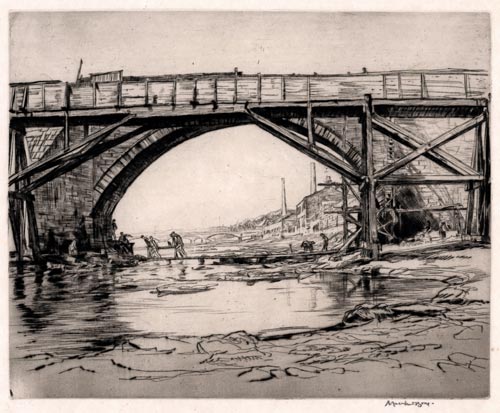 |
|
MUIRHEAD BONE
Glasgow 1876 – 1953 Oxford
A classic and important figure in the Modern British Etching Boom, Bone attended evening classes at Glasgow School of Art while training to be an architect, 1890-94. Architecture remained an important theme when he became a full time graphic artist and illustrator.
Bone was self-taught as an etcher, experimenting from 1898 with drypoint with his friend and fellow student Francis Dodd, whose sister he married five years later, 1903.
Bone settled in London in 1901.
In 1904 he was a founding member of the graphic art-orientated Society of Twelve.
Repairing the auld brig, Ayr, No 1
Campbell Dodgson 259
291 x 252 mm
Original drypoint, 1909.
Signed in pencil.
Forty proofs in all were printed through the eight states of the plate.
A fine impression, printed with selective plate tone, on japan.
£400
Return
to top ^
|
|
|
|
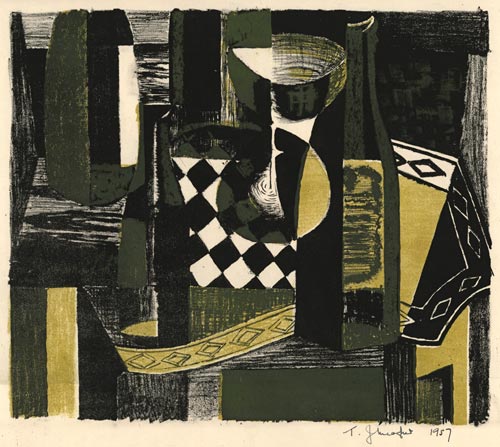 |
|
J T MEAGHER
Still life on a table top
285 x 335 mm
Original three-colour lithograph, 1957.
Signed in ink and dated.
On wove.
Sold
Return
to top ^ |
|
|
|
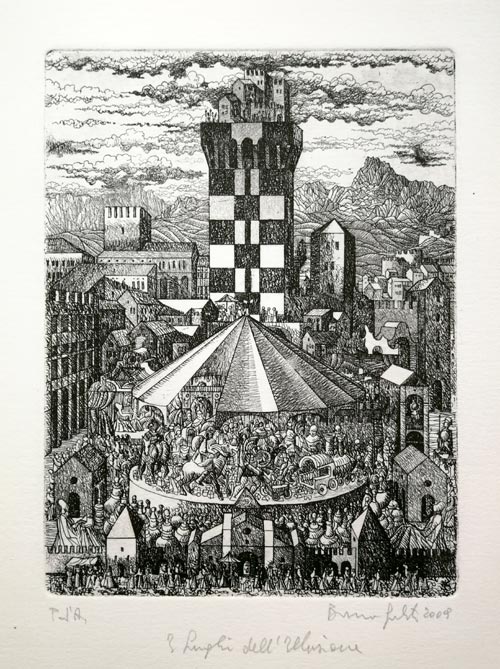 |
|
BRUNO GORLATO A.R.E.
Born Padua 1940, Died Padua April 2021.
Bruno studied architecture at Venice University and worked in town planning before devoting himself to painting, etching and teaching.
He was elected an Associate of the Royal Society of Painter-Printmakers in 2019.
I Luoghi dell’Illusione
176 x 130 mm
Original etching and aquatint, 2009.
Artist’s proof. Signed in pencil, dated and entitled.
On Fabriano wove paper.
With the artist’s blindstamp in the lower margin.
£150
Return
to top ^ |
|
|
|
|
|
|
|